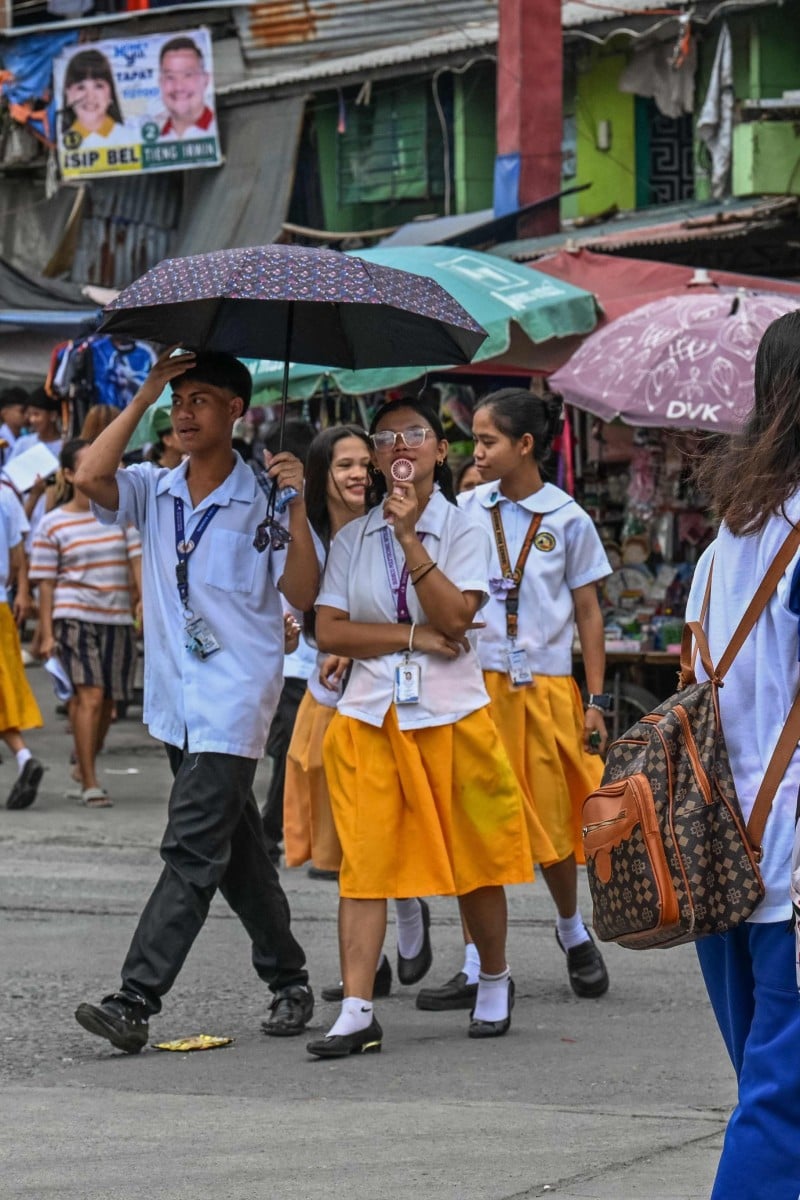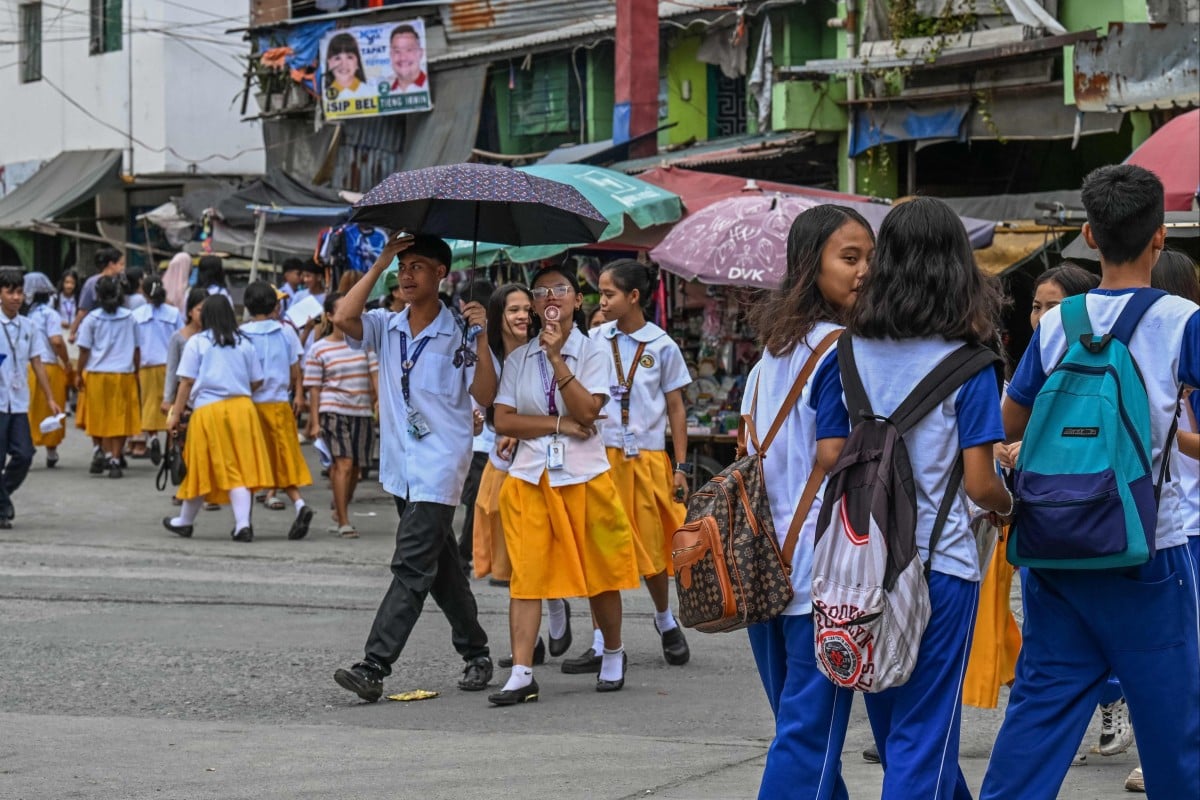
Climate change: extreme heat brings holidays early to Philippine schools
This school year started two months earlier than usual in Manila so that the term could end before May’s impossible heatwaves
 Last year, heatwaves forced millions of children in the Philippines out of school, prompting a series of changes. Photo: AFP
Last year, heatwaves forced millions of children in the Philippines out of school, prompting a series of changes. Photo: AFPIn Manila’s soaring heat, kindergarten teacher Lolita Akim fires up five standing fans – with three more at the ready – as she fights to hold the attention of her pint-sized pupils.
Last year, heatwaves forced millions of children in the Philippines out of school. It was the first time that soaring temperatures had caused widespread class suspensions, prompting a series of changes.
This school year started two months earlier than usual, so the term ends before peak heat in May. Classes have been rearranged to keep children out of the midday heat, and schools are equipped with fans and water stations.
The moves are examples of how countries are adapting to the higher temperatures caused by climate change, often with limited resources.
Your Voice: climate change apathy (short letters)
As a teacher, Akim is on the front lines of the battle to keep her young charges safe and engaged.
“In this weather, they get drenched in sweat; they become uneasy and stand up often. Getting them to pay attention is more difficult,” she said of the five-year-olds she cares for at Senator Benigno S. Aquino Elementary School.
According to the education department, some six million students lost up to two weeks’ worth of classroom learning last year when temperatures hit a record 38.8 degrees Celsius (101.4 degrees Fahrenheit).
Schools reported cases of heat exhaustion, nose bleeds and hospitalisations as students struggled through lessons in classrooms that did not have air conditioning.
Scientists say extreme heat is a clear marker of climate change, mainly caused by burning fossil fuels like coal, oil and gas. The seasonal El Nino phenomenon further exacerbated last year’s heat.
Nearly half of Manila’s schools were forced to close for two days in March when the heat index – a measure of temperature and humidity – hit “danger” levels.
“We’ve been reporting (the heat index) since 2011, but it’s only been recently that it’s become exceptionally warm,” national weather service specialist Wilmer Agustin told Agence France-Presse, attributing it to “El Nino and climate change”.
This year, conditions in most of the country will range between “extreme caution” and “danger” on the government’s heat alert system, he said, “especially in April and May”.
On Friday, many schools in Manila closed as temperatures were expected to hit 34C, while the national weather service said the heat index for at least five provinces would hit the danger level.
Education crisis in Pakistan leaves 26 million children out of school
During last year’s closures, alternative learning helped make up some of the gap. But “the overall impact on students’ education was significant”, said Jocelyn Andaya, assistant education secretary for operations.
So this year, a series of measures have been instated to avoid further learning loss.
Classroom sessions have been shortened to four hours a day – avoiding the searing midday sun – and water stations were installed in each classroom, as well as at least two oscillating wall fans.
Some newer schools have heat-reflective roofs, and bigger ones now employ nurses.
Just three per cent of students affected by last year’s heatwaves were able to access online classes, so this year, printed material was prepared for students if they must stay home.
But Benigno Aquino school principal Noel Gelua cautioned that “there is no real alternative to face-to-face learning.”
There are limits to what can be done, given the education department has a budget of just 10 billion pesos ($174 million) for climate adaptation, infrastructure and disaster readiness.
The Philippines also has a perennial classroom shortage, with 18,000 more needed in the capital alone. Manila’s public schools do two shifts per day, with about 50 students in each 63 square-metre (678 square-foot) room, exacerbating the heat problem.
Fifth-grader Ella Azumi Araza, 11, can only attend four days a week due to the shortage. On Fridays, she studies in her family’s nine-square-metre cinderblock home on a bed she shares with her younger brother, who has epilepsy.
Three electric fans are always on in the windowless, single-room structure.
As hot as it is at home, her mother, Cindella Manabat, still frets about conditions at school, saying that she comes home coughing.
“I make her carry a jug of water to prevent dehydration,” she said.
Across the street from Benigno Aquino, eighth-graders at President Corazon C Aquino High School aimed tiny, rechargeable fans at their bodies while taking an algebra quiz. Two of the four ceiling fans in the room had given out, and the remaining two were clearly not enough for the 40 students.
“It is very difficult to teach in the heat,” their teacher Rizzadel Manzano said. “Motivating them is really a challenge.”
Starting this year, a school uniform is no longer required, allowing students to wear sweatpants and T-shirts donated by the city, principal Reynora Laurenciano told Agence France-Presse.
Both schools are located in a densely populated slum area called Baseco, where conditions at home can be even more dire, she added.
“If you ask them, they consider (school) a safer place,” Laurenciano said.